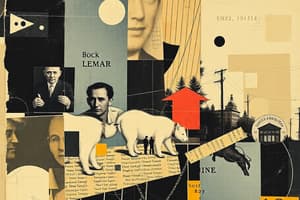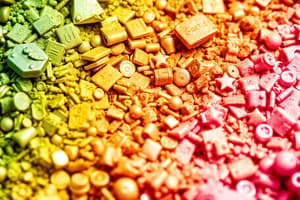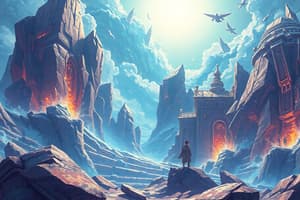Podcast
Questions and Answers
Why can't a scale model of the solar system be accurately made?
Why can't a scale model of the solar system be accurately made?
- The interplanetary distances are too great. (correct)
- There are too many planets to include.
- The model would take up too much space.
- The sizes of planets are too small.
Models of large objects, such as the solar system, are often made to scale.
Models of large objects, such as the solar system, are often made to scale.
False (B)
What is an example of a model that must be made to scale?
What is an example of a model that must be made to scale?
Blueprints for a building.
The sun would be about the size of a ______ in a model of the solar system on a football field.
The sun would be about the size of a ______ in a model of the solar system on a football field.
Match the following descriptions with the correct term:
Match the following descriptions with the correct term:
What is the charge of a proton?
What is the charge of a proton?
Neutrons have a positive charge.
Neutrons have a positive charge.
What is the approximate mass of an electron in kg?
What is the approximate mass of an electron in kg?
Protons have a mass approximately _____ times that of an electron.
Protons have a mass approximately _____ times that of an electron.
Match the particles with their properties:
Match the particles with their properties:
If an atom is neutral, how do the numbers of protons and electrons compare?
If an atom is neutral, how do the numbers of protons and electrons compare?
Electrons are larger than protons and neutrons.
Electrons are larger than protons and neutrons.
What do atomic models help scientists do?
What do atomic models help scientists do?
Who was the scientist that discovered the electron?
Who was the scientist that discovered the electron?
Cathode rays bend toward a negative charge.
Cathode rays bend toward a negative charge.
What is the charge of the particles that make up cathode rays?
What is the charge of the particles that make up cathode rays?
If electric current causes a cathode ray to bend toward a positive charge, the ray must be __________ charged.
If electric current causes a cathode ray to bend toward a positive charge, the ray must be __________ charged.
Match the following components of a cathode-ray tube with their functions:
Match the following components of a cathode-ray tube with their functions:
What did J.J. Thomson calculate from his experiments?
What did J.J. Thomson calculate from his experiments?
The charge-to-mass ratio of cathode ray particles changes with different gases.
The charge-to-mass ratio of cathode ray particles changes with different gases.
What is a cathode ray?
What is a cathode ray?
What occurs when a negatively charged balloon is placed near a stream of water?
What occurs when a negatively charged balloon is placed near a stream of water?
Like charges attract each other.
Like charges attract each other.
What phenomenon is observed when you touch a metal object after walking on a carpet?
What phenomenon is observed when you touch a metal object after walking on a carpet?
When two objects with opposite charges come together, they will ______.
When two objects with opposite charges come together, they will ______.
What did scientists conclude about the properties of elements over time?
What did scientists conclude about the properties of elements over time?
Match the following concepts to their descriptions:
Match the following concepts to their descriptions:
A charged balloon can build up a negative charge when rubbed with cloth.
A charged balloon can build up a negative charge when rubbed with cloth.
Why does a balloon attract a stream of water?
Why does a balloon attract a stream of water?
What was the main hypothesis of Rutherford regarding the plum pudding model?
What was the main hypothesis of Rutherford regarding the plum pudding model?
In the gold foil experiment, most alpha particles were deflected at large angles.
In the gold foil experiment, most alpha particles were deflected at large angles.
What did the scattering of a few alpha particles at large angles indicate about atomic structure?
What did the scattering of a few alpha particles at large angles indicate about atomic structure?
During the gold foil experiment, ____ alpha particles were deflected backwards from the foil.
During the gold foil experiment, ____ alpha particles were deflected backwards from the foil.
Match the following components of the gold foil experiment with their descriptions:
Match the following components of the gold foil experiment with their descriptions:
What was a surprising result observed by Rutherford during the gold foil experiment?
What was a surprising result observed by Rutherford during the gold foil experiment?
The gold foil experiment supported the plum pudding model of atomic structure.
The gold foil experiment supported the plum pudding model of atomic structure.
What conclusion did Rutherford reach about atomic structure based on the results of his experiment?
What conclusion did Rutherford reach about atomic structure based on the results of his experiment?
What property do metalloids possess that is useful in technology?
What property do metalloids possess that is useful in technology?
Nonmetals are generally brittle at room temperature.
Nonmetals are generally brittle at room temperature.
Name two examples of metalloids.
Name two examples of metalloids.
Metalloids have characteristics of both metals and __________.
Metalloids have characteristics of both metals and __________.
Match the following elements with their classifications:
Match the following elements with their classifications:
What historical perspective did scientists hold about atoms in the mid-1800s?
What historical perspective did scientists hold about atoms in the mid-1800s?
Metalloids can only be found in gaseous state at room temperature.
Metalloids can only be found in gaseous state at room temperature.
What change regarding the understanding of atoms occurred over time?
What change regarding the understanding of atoms occurred over time?
Flashcards
Metalloids
Metalloids
Elements that share characteristics of both metals and nonmetals.
Metals
Metals
Elements that are typically shiny, malleable, and good conductors of heat and electricity.
Nonmetals
Nonmetals
Elements that are typically dull, brittle, and poor conductors of heat and electricity.
Atom
Atom
Signup and view all the flashcards
Atomic Theory
Atomic Theory
Signup and view all the flashcards
Early Atomic Model (1800s)
Early Atomic Model (1800s)
Signup and view all the flashcards
Electrical Conductivity
Electrical Conductivity
Signup and view all the flashcards
Thermal Conductivity
Thermal Conductivity
Signup and view all the flashcards
Scale Models of Large Objects
Scale Models of Large Objects
Signup and view all the flashcards
Scale Model Importance
Scale Model Importance
Signup and view all the flashcards
Scale Definition
Scale Definition
Signup and view all the flashcards
Scale Models in Construction
Scale Models in Construction
Signup and view all the flashcards
Atomic Scale Analogy
Atomic Scale Analogy
Signup and view all the flashcards
Electronegativity
Electronegativity
Signup and view all the flashcards
Electron
Electron
Signup and view all the flashcards
Nucleus
Nucleus
Signup and view all the flashcards
Protons
Protons
Signup and view all the flashcards
Neutrons
Neutrons
Signup and view all the flashcards
Electrostatic force
Electrostatic force
Signup and view all the flashcards
Atomic number
Atomic number
Signup and view all the flashcards
Cathode ray
Cathode ray
Signup and view all the flashcards
Cathode
Cathode
Signup and view all the flashcards
Anode
Anode
Signup and view all the flashcards
Deflection of cathode rays
Deflection of cathode rays
Signup and view all the flashcards
Charge-to-mass ratio
Charge-to-mass ratio
Signup and view all the flashcards
Cathode ray tube experiments
Cathode ray tube experiments
Signup and view all the flashcards
J.J. Thomson
J.J. Thomson
Signup and view all the flashcards
Atomic Nucleus
Atomic Nucleus
Signup and view all the flashcards
Atomic Model
Atomic Model
Signup and view all the flashcards
Neutral Atom
Neutral Atom
Signup and view all the flashcards
Relative Size of Subatomic Particles
Relative Size of Subatomic Particles
Signup and view all the flashcards
Observing Atoms
Observing Atoms
Signup and view all the flashcards
Plum Pudding Model
Plum Pudding Model
Signup and view all the flashcards
Alpha Particles
Alpha Particles
Signup and view all the flashcards
Gold Foil
Gold Foil
Signup and view all the flashcards
Gold Foil Experiment
Gold Foil Experiment
Signup and view all the flashcards
Most Alpha Particles Passed Through
Most Alpha Particles Passed Through
Signup and view all the flashcards
Some Alpha Particles Deflected
Some Alpha Particles Deflected
Signup and view all the flashcards
Few Alpha Particles Deflected Backwards
Few Alpha Particles Deflected Backwards
Signup and view all the flashcards
Study Notes
Comparing Elements Based on Properties
- Matter can be classified into pure substances or mixtures
- Metals shown in the figure are pure substances
- Different metals react differently with acids
- Metals are elements, or pure substances
Classifying Elements
- Elements are classified as metals, nonmetals, or metalloids
- Metals are shiny, good conductors of electricity and heat, and generally bendable solids at room temperature
- Nonmetals are poor conductors, often gases at room temperature, and can be brittle
- Metalloids have characteristics of both metals and nonmetals, and are solids at room temperature. They are not as brittle as nonmetals, and conduct electricity less well than metals, but more than nonmetals. Used in computer chips (e.g., boron, silicon)
Understanding Atoms
- Scientific understanding of the atom has evolved over time
- Early models of atoms depicted them as tiny indivisible spheres (differing only in mass)
- Experiments showed that atoms aren't indivisible
- Certain elements react with substances but others don't
- Noble gases (e.g., helium, neon, argon) are barely reactive
- Noble gases emit different colors of light when electric current passes through them
Investigating Atomic Structure
- Opposite charges attract, while like charges repel.
- Experiments with cathode rays revealed the existence of electrons
- Electrons have a negative charge and extremely small mass (much smaller than an atom)
Identifying the Nucleus
- Atoms have a nucleus (small, dense positively charged core), surrounded by a negatively charged electron cloud.
- The gold foil experiment provided evidence for the atomic nucleus
- Most alpha particles passed straight through the gold foil
- A few alpha particles were deflected at large angles
- The results contradicted the plum pudding model of the atom
Describing Atomic Structure
- Atoms are composed of subatomic particles: electrons, protons, and neutrons
- Electrons have a negative charge and very small mass
- Protons have a positive charge and a relatively large mass
- Neutrons have no charge and a relatively large mass
- Atoms are mostly empty space (containing the nucleus)
Scale and Atomic Models
- Atoms are too small to observe directly
- Atomic models help visualize atomic structure
- Models are often not drawn to scale because of the extreme differences in size and distances involved
- Some models requiring scale (e.g., blueprints)
Studying That Suits You
Use AI to generate personalized quizzes and flashcards to suit your learning preferences.




